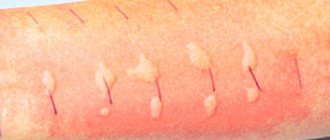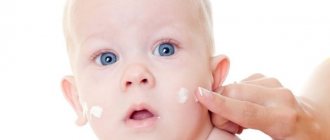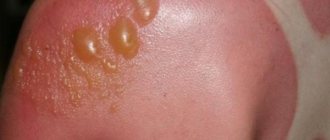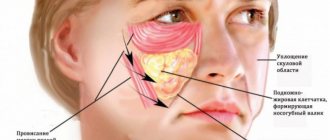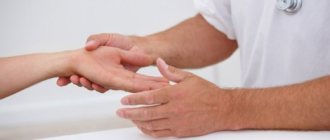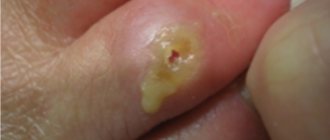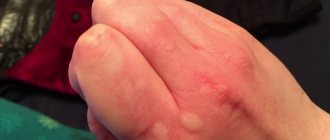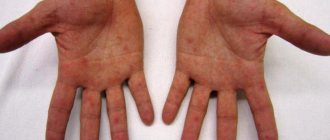What it is?
A blister is a swollen piece of the upper layer of skin that occurs when it rubs against the shoe material.
This is a neoplasm in the form of an inflated bubble, dense to the touch, having a different shape.
There is liquid inside them, so when pressed they spring slightly. On the feet, blisters often appear on the feet, between and on the toes.
Their sizes can be different : from small bubbles to quite large bubbles.
There are cases when numerous blisters merge into one large pillow. The color of the bubbles ranges from pale pink to yellowish-white with pink edges.
Causes of fluid blisters
The appearance of tumors on the legs can occur for a variety of reasons. These may include the negative influences of external factors, as well as various diseases.
Quite often the pathology is observed against the background of burns. They appear if a person spends a long time in a solarium or under the influence of direct sunlight.
When pathology appears against the background of this cause, the blisters become red in color. Neoplasms are characterized by severe pain. When insect bites, new growths may appear on the legs in various places.
If they appear on the foot or between the toes, this leads to discomfort. The simplest and most obvious factor in the occurrence of neoplasms is tight shoes, which often rub.
The appearance of a pathological condition is quite often observed against the background of various diseases:
- Skin diseases. If a person is diagnosed with diseases of the epidermis, then there may be no redness near the tumors. Most patients claim that the disease is not accompanied by itching. Skin diseases are characterized by a fairly long course, regardless of the chosen therapy method.
- Fungal diseases.
When exposed to fungi, neoplasms on the skin of the legs are observed quite often. Infection with a fungal infection is diagnosed in places of common use - baths, saunas, swimming pools. In the initial stages of the disease, slight redness appears on the legs. After a certain time, the skin begins to exfoliate in these areas. This may cause blistering or cracking of the skin. After a few days, the blisters may burst on their own. - Allergic reactions. When they appear, a rash appears on the patient’s legs, which in appearance resembles tiny blisters. During the course of this pathology, patients experience quite severe itching. In places where the rash appears, unbearable pain is diagnosed. In this case, it is recommended that the source of the allergy be determined.
If the patient is not sure that the cause of the appearance of tumors is an external factor, then he is recommended to seek help from a doctor who will not only make a correct diagnosis, but also prescribe rational treatment.
Causes
The true cause of their appearance on the legs can be determined by a dermatologist. Most often, the reasons for their formation are the following:
- Uncomfortable shoes - tight or too loose, made of rough materials or with hard elements protruding inward. Blisters form from friction of the skin against such shoes.
- Allergic reactions to food, medications or chemicals. Such blisters are cured after the use of antihistamines.
- Fungal infection . Its presence can be indicated by a large number of small blisters on the feet, which are very itchy.
Sometimes a blister that appears suddenly can disappear just as suddenly. But often it causes a lot of inconvenience or begins to cause pain and itch. The worst thing is when it breaks through and begins to fester.
Sometimes the blister begins to itch unbearably. This may be the case if it is a consequence of a fungal infection or an allergic reaction. It is not recommended to scratch it, as this can damage the membrane and cause infection. Then suppuration will appear in its place, and the problem will worsen.
Care and further healing
To quickly restore the skin and heal the wound without a trace, it is necessary to treat the callus and follow certain recommendations:
- change dressings regularly;
- do not burst blisters unless necessary;
- Before touching a callus on your foot, wash your hands thoroughly;
- use antiseptic agents when processing;
- pierce only with a sterile needle;
- After the puncture, do not peel off the remaining skin;
- if there is a callus on the foot, stop wearing tight shoes;
- use drugs for rapid healing.
With proper care, which can be provided at home, the wound can heal quickly without leaving a mark. To allow blisters to appear, it is enough to remove the factors that provoke their appearance.
Wet callus is not dangerous to human health. However, if not properly cared for, it can lead to significant complications that are difficult to cure. To prevent this, you need to pay attention to hygiene and take care of your own body.
The article has been verified by the editors
First actions upon appearance
It is not recommended to pierce them to avoid infection.
If the formation is small and it is possible to preserve its integrity by protecting its area from the shoe material, then it is better to wait for it to pass naturally.
When the bubble is of impressive size, it most often causes inconvenience, and it will most likely not be possible to save it without injuring it.
In this case, it is more advisable to pierce before it collapses on its own. If this happens, dirt may get into it and it will become inflamed.
Before the procedure, wash your feet and hands thoroughly. Prepare a needle that has been disinfected with alcohol or burned. Wipe the blister with alcohol and make a small puncture at the base, closer to the intact skin. Squeeze out all the liquid from the bubble.
IMPORTANT Do not cut off the top layer of skin from the blister; such a wound will take a very long time to heal.
Press the skin against the wound, it will help protect the inner surface from infection . Cover the sore spot with adhesive tape. If the blister area is large, apply a gauze bandage.
ATTENTION The surface under the bandage must be constantly dry, otherwise this area will become inflamed.
Change the bandage daily, and if possible twice a day, to eliminate the slightest possibility of the blister inside getting wet.
If possible, the bandage should be removed: at night or when you are at home and you can walk without shoes. This way healing will happen faster as the skin will dry out. A completely dry and well-protected blister from infection will soon dry out and fall off on its own. Underneath you will find completely healthy skin.
How does dropsy of the feet occur?
Dropsy, or swelling, occurs due to an imbalance between the flow of fluid into the tissues of the legs and their removal through the venous network or through the lymphatic system. Another cause of dropsy is increased vascular permeability, their pathological expansion, and, as a result, increased release of water into the surrounding tissues.
Violation of the osmotic properties of blood is the reason for the appearance of edema of the lower extremities. Violation of blood biochemistry, a decrease in the concentration of sodium, chlorides and proteins, a decrease in the amount of hormones that regulate metabolism, lead to a disorder in the drainage function of the lymphatic and venous systems.
Dropsy is not a separate disease; on the contrary, functional disorders of the cardiovascular system, liver and kidneys are manifested by swelling of the legs.
Treatment method
To choose a treatment method for a tumor, first of all, it is necessary to find out the cause of its formation. If it is a fungus or an allergic reaction, you must first treat the underlying cause by consulting your doctor.
Blisters caused by friction with uncomfortable shoes can be treated in two ways:
Pharmacy drugs
- Foot cream with aloe vera;
- Lavender oil under a bandage – castor oil with vitamin E;
- Levomethicin ointment. Used for redness of the blister;
- Panthenol. Used to lubricate blisters and prevent inflammation;
- Gehwol (Gevol) "Blasenpflaster";
- Fusscraft;
This healing patch is designed specifically to treat water blisters. It contains and gradually releases a special gel from its surface, which relieves pain and protects the skin during treatment.
A herbal bath made from herbal ingredients that softens blisters and calluses.
Aloe Vera Foot Cream
Lavender oil
Levomecithin ointment
Panthenol ointment
Gehwol range
Fusscraft foot bath
They may appear when removing a wart with nitrogen, during frostbite, and other cases. Find out whether blisters that form on the skin with fluid can be pierced. On the body, blisters that itch can appear in different places: on the back, eye, ear, butt, penis and even in the hair on the head.
Folk remedies
- Baths with low concentration potassium permanganate or salt. Take them for 15 minutes.
- Tea tree oil. Used to lubricate a blister.
- The film from under the shell of a raw egg. It is glued to the bubble, and it disappears in two to three days.
- Compress with a decoction of string. 4 tablespoons of leaves are steamed in a water bath for 30 minutes, cooled, a napkin is moistened with the decoction and placed on the blister.
- A ring made of mole hair (or any other animal hair). A very exotic method, but, according to reviews, quite effective. Wool should be placed around the bladder, and it will protect it from rupture and infection of the inner surface.
IMPORTANT Do not try to press on the blister. If it is possible not to injure it, it is better to wait for its natural disappearance.
Treatment for blisters between toes in a child
Have you been trying to cure FUNGUS for many years?
Head of the Institute: “You will be amazed at how easy it is to cure fungus by taking it every day...
Read more "
Redness between the fingers is very often noted by parents in their children. As you know, children are very curious; they learn about the outside world by touching various objects.
When playing on a playground where there is dirty sand, picking up twigs and pebbles from the ground, a huge amount of pathogenic bacteria gets on their hands, which can cause redness and rash.
There are other causes of red spots between the fingers; they can be of viral etiology or be the result of insufficient hygiene. A doctor can determine exactly what caused the redness between the fingers based on a visual examination and a series of laboratory tests.
Features of therapy for certain types
The treatment method for blisters depends on where they are located and their condition:
- Liquid blisters on the legs;
- For swelling of the legs;
- For diabetes;
- Blister on the foot;
- Blood blister;
They are treated with special patches, which are a pad with a gel filler.
Its purpose is to protect against neoplasm and prevent rupture and infection. Such a patch is glued onto a bubble smeared with green paint. The period of use of the product depends on the state of education. You should wait for the bubble to completely disappear.
Slight swelling of the legs in the evening is normal. Therefore, plan for this, and if you will be on your feet for a long time, take the loosest possible shoes with you to change your shoes. This will help you prevent the skin from squeezing and causing blisters. If edema is a consequence of any disease, then it is necessary to treat it first. While swelling symptoms are relieving, use protective patches and pads to help protect the skin of your feet.
This disease can cause blisters to form on the skin, similar to burn blisters. They may appear on the toes, feet, and legs. Direct treatment of these formations is not required. The main task in this case is systematic control of blood sugar levels. If sugar is normal, the blisters will disappear on their own without additional treatment.
The latest development of the German company Genvol - Oval protective plaster will save you from them. It is glued to the problem area of the foot and protects it from excessive friction and pressure. This patch is especially recommended for lovers of high heels.
Appears if friction occurs in the area where a blood vessel is located.
It occurs on the fingers or heels in places of greatest contact with the rough skin material.
If you feel pain in a specific area while putting on your shoes, you need to protect that area of skin in advance, without waiting for a blood blister to form. Applying a protective bandage or wearing socks will help prevent irritation.
In case of blood tumors foot hygiene to prevent accidental infection of the wound. If a blood blister accidentally breaks, immediately disinfect the affected area and cover it with a bandage. Under no circumstances should the top film be removed; press it to the area of the bubble and cover it with adhesive tape.
Why do water blisters appear on the legs and what is their treatment?
Water bubbles on the feet do not look very aesthetically pleasing and cause discomfort to a person while wearing shoes. During sports or even just intense and prolonged walking, a fluid-filled bladder may burst. If not treated in time with antiseptic agents, an open wound formed in its place can cause an inflammatory process.
What is a disease
Transparent blisters on the toes are a kind of skin formation that is filled with a clear or slightly cloudy liquid. What is this small bag filled with? Exudate or effusion is liquid that accumulates in tissues or cavities in the presence of an inflammatory process in the body. This is a kind of protective mechanism of the body.
The color and size of the exudate depend directly on the cause of the bubbles. The shape of the formations can also be varied and not always round. Traditionally, blisters are localized on the delicate skin between the toes. They do not pose a direct threat to human health, but can cause inconvenience, irritate the skin and even cause pain.
If such a cosmetic flaw occurs in a representative of the fair sex, then psychological discomfort also occurs.
Many girls even try to open the formations to remove fluid and make the bubbles less noticeable.
Of course, this is not worth doing, since the resulting wound will cause even more pain, and if disinfection is insufficient, pus and inflammation may appear.
If such blisters appear in a child, then parents should carefully ensure that the child does not damage the skin while playing. If the baby is very small and there is no way yet to explain to him why the bags should not be torn or scratched, you should try putting the child in cotton socks to protect the bubbles from mechanical stress.
If possible, the open wound at the site of the damaged dropsy should be covered with a plaster. It must be regularly cleaned of contaminants and treated with hydrogen peroxide. The “Rescuer” balm will help speed up the healing process and slightly reduce pain.
What causes dropsy to appear?
There are quite a lot of factors that provoke the appearance of blisters on the feet. Some of them do not pose a threat to humans, while others indicate the presence of a disease, inflammatory process or other hidden problem in the body that must be identified. Most often, blisters on the feet appear for the reasons listed below.
Fungal disease
Some varieties of fungi are able to remain active and viable for an extended period of time, spreading infection to various parts of the lower extremities.
Since the affected areas become very itchy, the itching can cause a person great discomfort. The skin often begins to peel and crust over.
Allergy
A watery rash often appears as a protective reaction of the body to a certain irritant. In addition to the rash, the person also suffers from unpleasant itching. Since there is now a wide selection of antiallergic drugs on pharmacy shelves, many people who are faced with a problem try to deal with it on their own at first, without turning to a specialist.
But such actions often remain ineffective. Without identifying the allergen with a view to its subsequent elimination, the patient’s condition will constantly worsen at the first contact with it. Allergens can include food, skin care products and household chemicals.
Skin diseases
There is an extensive list of diseases that manifest themselves through the formation of watery blisters on the skin. Only a specialist can correctly diagnose and prescribe treatment.
Therefore, you should not try to select medications and ointments on your own, since using the wrong remedy can aggravate the course of the disease.
Sunburn
Excessive exposure to direct sunlight can cause a real sunburn. In addition to a cosmetic defect on the skin, a person’s body temperature rises, chills, vomiting, and dizziness appear. Blisters on the toes and feet due to sunburn are rare, but the possibility cannot be ruled out.
To relieve discomfort and pain from burns, as well as to protect against infection, it is recommended to use Levomekol and Panthenol ointment at home. These products accelerate the process of skin regeneration and damage healing.
Insect bites
Some types of insects can cause the formation of a rash, red dots, and blisters filled with liquid. This reaction of the body can also be regarded as an allergy.
Blisters on the feet and toes do not often cause concern in a person, so very few people turn to a doctor for qualified help. Most people try to cope with the disease on their own, which is absolutely wrong. By the appearance of dropsy on the skin, the body tries to let a person know about the presence of more serious diseases.
Caring for a watery rash depending on its type
Determining the root cause of the blisters is critical to successfully getting rid of them. Equally important are measures to alleviate a person’s discomfort due to a rash. The treatment method is chosen depending on the appearance of the blisters, their size, location and even color.
The following types of blisters are distinguished:
When is medical help needed?
An emergency case of seeking medical attention is inflammation at the site of a blister. Symptoms of the onset of inflammation are the following:
- Severe, ever-increasing pain in the area of education.
- Redness or increased temperature of the surrounding skin.
- Discharge of blood or pus from the blister.
- Increased body temperature.
- Inflammation of the lymph nodes on the body.
- Suspicion of a fungus. This is evidenced by numerous small bubbles on the fingers and between them. In this case, severe itching is observed.
If you notice at least one of these signs, consult a doctor ! At the hospital, your blister will be opened under sterile conditions, disinfected, and anti-inflammatory medications will be prescribed.
If you are unable or unwilling to see a doctor for treatment, or decide to treat them yourself, remember the following:
- Do not allow the bubble to develop too hard and yellow-brown in color.
- Monitor treatment time. If recovery is delayed, it is better not to risk it and still consult a doctor.
- Before using pharmaceutical products, carefully read the instructions and do not violate them under any circumstances.
Prevention of wet calluses
- Do not go out for long distances in new shoes, break them in gradually.
- Don't wear the same shoes two days in a row.
- Treat the most pressing areas with a special pencil to prevent chafing.
- Choose socks made from a mixture of acrylic and cotton, not cotton
- If your feet sweat, use deodorant or talc
- Choose soft leather shoes strictly according to size
- In places where the skin is most often subject to abrasion, special silicone pads can be glued into shoes.
- At the first signs of chafing of the skin of your legs, stick a regular bandage to these places.
Traditional medicine in the fight against wet calluses
If you follow all the rules, you can easily cope with sore feet on your own, but if there are signs of infection or unbearable pain, then you need to see a doctor as soon as possible.
Causes of edema in combination with pain syndrome
Violation of the outflow of lymph and venous blood, combined with pain, usually provokes an inflammatory process. Swelling caused by inflammation occurs when there is bacterial infection and injury to the extremities.
Causes of dropsy accompanied by pain:
- Filariasis – causes inflammation of the lymphatic vessels and lymphostasis.
- Thrombosis of the lower veins - disturbances in the removal of toxic metabolic products provoke their effect on nerve endings. Metabolites cause inflammation, tissue swelling and pain.
- Myositis – inflammation of the muscles of the lower extremities damages the nerve endings that innervate them. The muscles become inflamed and increase in size and swell.
- Lymphangitis - stagnation of lymph in inflamed vessels irritates nerve endings, because swollen tissues cause mechanical compression of the nerves.
- Fatty edema - the growth of adipose tissue provokes periodic inflammatory phenomena in the subcutaneous tissue and the appearance of pain.
- Mechanical damage to the extremities - trauma contributes to damage to the structure and functionality of blood vessels, nerves, skin, muscles of the leg bones, which causes an inflammatory process in these tissues. Symptoms include pain and swelling.

